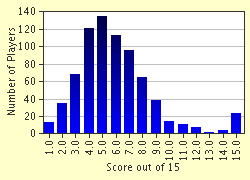Quiz Answer Key and Fun Facts
1. Which of these statements best describes Mary Magdalene, as she is depicted in the New Testament?
2. From what affliction did Christ cure Mary, according to St. Luke's gospel?
3. The name "Magdalene" indicates that Mary hailed from Magdala (also known as Majda, Magadan or Migdal). Where in the Holy Land was Magdala?
4. According to a legend which appeared in the Middle Ages, Mary Magdalene was the bride at the Wedding at Cana; St. John the Evangelist was the bridegroom.
5. Each of the four Gospels describes Mary as being present at the Crucifixion and three mention her bringing spices to anoint the body of Christ on the morning of the Resurrection. According to one gospel, however, Mary was the first person to encounter Christ after the Resurrection. Which gospel is this?
6. Although Mary Magdalene is prominently mentioned in the Gospels, she is not quoted as uttering a single word in any of them.
7. A 1600 painting by the Spanish artist El Greco departs from tradition by depicting Mary Magdalene as being present at this important event in the early church.
8. A fragmentary Gnostic "Gospel of Mary" was discovered in 1896 by Dr. Carl Reinhardt in Cairo Egypt. It was eventually published in 1955, though it is not recognized as part of the New Testament. In this narrative, Mary is depicted as being the driving force behind the disciples after the death of Christ. At one point in the narrative, she is challenged by Andrew and, especially, Peter who refuses to believe that Jesus had revealed things to her, a woman, that he had not revealed to them. Mary is defended, however, by this disciple, himself the author of one of the Gospels.
9. The calendar of the Catholic Church used to list Mary Magdalene as a "penitent". By what title is she designated in the current church calendar?
10. Both the Eastern and the Western churches celebrate the feast of St. Mary Magdalene on July 22. How is she described in the Eastern calendar?
11. Which of these words is derived from the name "Magdalene"?
12. According to legend, Mary Magdalene is supposed to have traveled to France after the ascension of Christ. Which part of France is she said to have evangelized?
13. According to Catholic tradition, Mary Magdalene is the patron saint of which profession?
14. A beautiful and famous Romanesque-style church dedicated to St. Mary Magdalene is a prominent feature of this major European city.
15. The Catholic liturgy for the feast of St. Mary Magdalene includes a beautiful reading from which of these Old Testament books?
Source: Author
jouen58
This quiz was reviewed by FunTrivia editor
fringe before going online.
Any errors found in FunTrivia content are routinely corrected through our feedback system.

